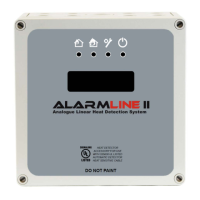
Do you have a question about the Kidde Alarmline II and is the answer not in the manual?
| Category | Fire Alarm Cable |
|---|---|
| Application | Fire Alarm Systems |
| Shielding | Unshielded |
| Jacket Color | Red |
| Voltage Rating | 300V |
| Conductors | 2 |
| Conductor Material | Copper |
| Insulation Material | PVC |
Details legal limitations on the manufacturer's liability for damages.
Explains different types of advisory messages (Warning, Caution, Note) used in the manual.
Provides a general introduction to the Alarmline II Dual Zone Digital Location Control Unit.
Describes the mode where two LHD zones operate as independent detection circuits.
Details the mode requiring both zones to be in alarm for activation, ensuring failsafe operation.
Instructions on how to physically mount the control unit enclosure.
Details the wiring for Alarmline II Digital Sensor Cables to the control unit zones.
Explains how to connect control unit outputs to a main fire alarm system.
Guides through the general process of configuring the control unit using its buttons.
Outlines the main menu options and specific actions like loading configs or self-testing.
Step-by-step guide to set the operating mode (Independent or Interlock).
Instructions for setting the alarm temperature for each sensor cable zone.
Details how to configure the use of leader cables for sensor zones.
Explains how to enable or disable latching for status outputs.
Guides on enabling the Modbus communication interface for data output.
Details setting Modbus address, baud rate, data bits, and stop bits.
Instructions for setting the parity for Modbus communication.
Steps to reset the control unit to its original factory configuration settings.
Details how system status changes are displayed on the LCD.
Explains the alarm and fault indication for a short circuit in the interposing cable.
Details the cause and indication of a zone fault, typically an open circuit.
Describes the condition and implications of a relay fault.
Explains how EMC interference can cause faults and how to address them.
Details the causes and indications of ground faults in sensor or interposing cables.
Step-by-step guide to perform a self-test of the control unit's functionality.
Explains the specific Modbus function code used for reading input registers.